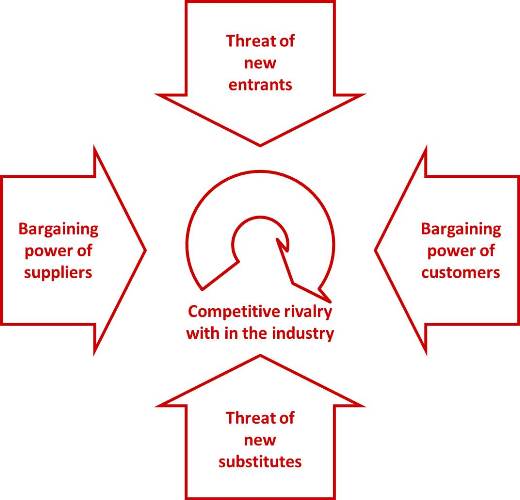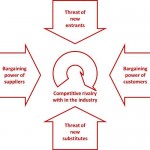The Porters Five Forces Model has lasted a number of years now. Nevertheless, it is still well known and still part of the curriculum of many courses on management and strategy. Much has been written on it. Still, it has its merits as management tool, and still it receives its share of criticism. In this post I share some ideas on how to use the Five Forces Model.
Popular criticism of the Porters Five Forces Model
One of the main points of criticism is that the Five Forces Model is rather static. It describes the current state of an industry, and thus seems rather unsuitable for our dynamic, ever changing and uncertain world. In my experience, a major problem with the model is that it is seen as an exercise for
- Business school students that lack the experience to make sense of the business environment in more suitable ways
- Managers that have to organize a strategic planning meeting and don’t know where to start.
In this context the model is used like a textbook exercise or an item on the agenda which is rather unrelated with the real world. I guess this is one reason for the model’s partly poor reputation. An often overlooked fact in such discussions is that the benefit of a management tool always depends on the user: It is up to you what you make of it. There is no lay that says the Porters Five Forces Model is only to be used for a static industry analysis.
A different perspective on the Five Forces Model
So let’s start to perceive this model as a structure that helps to organize information, ideas and thoughts. It helps to set different pieces of information in a common context and thus may provide the starting point for new ideas and insights.

Here are some ideas I came up with on what else to do with the Porters Five Forces Model:
How will the five forces develop in future?
The five forces are not only at work at present, but also in future. This is much more interesting since most of us already have a basic understanding about the current state of an industry. One may simply start to analyze how the five forces will develop in future.
Alternatively, one may start with one or two relevant trends or drivers for change. How will these affect the five forces? This is a good starting point for a set of scenarios too. As an example we can look at the German “Energiewendeâ€. As a result of the Japanese Fukushima-disaster, German government decided to shut down all German nuclear power plants within a relatively short timeframe, and instead to significantly increase the proportion of alternative or renewable energy sources. Many aspects of this “Energiewende†are still uncertain. However, one thing is very clear: Companies with energy-intensive production processes will face massive problems, since energy prices are expected to rise to new highs. What could we expect for such industries: the price increase will increase the pressure on margins and thus competition within the industry.
It could also motivate businesses in an affected industry to intensify their cooperation, for instance to improve their lobbying power or to set up joint projects to secure a reliable energy supply for the whole industry – hence, to reduce competition. A change in the ration between energy costs and transportation costs also might motivate companies to rethink their location decisions. The result could be a new trend to relocate energy-intensive production processes abroad – which would in turn have a massive impact on the German economy. Most probably, the threat of new entrance in such an industry would diminish. On the other hand, the “Energiewende†could also initiate an enormous new wave of innovation in the areas of energy efficiency, production technology, product design etc. This would open up niches for new entrants as well as for substitutes.
Structuring of decision processes
I once led a workshop on the strategic realignment of a business segment that so far had failed to meet expectations. It was a relatively new service offer, which was hoped to support sales of the core product and to open up new revenue streams. (Here is a bit more about this workshop)
At this workshop, nobody intentionally applied a Porters Fife Forces analysis. But actually, that was exactly what we were doing: We talked about our customers and our competitors in detail (supply side was irrelevant in that case). As for the buying power of customers, we analyzed what other options they might have – not to do anything at all was the most prominent answer and hence, we started to develop sales arguments to convince those customers that think they could live without our service. Than we elaborated on the risk that even more players could enter that particular market. In doing so, we did not only ask, who might plan to do so, but also how they would probably do this – from this we gained some insights and ideas for our own business activities.
So, if you have to structure a decision process, you could as well do it along those five forces of Porters Five Forces model. Although it might be wise not to mention the model at all – to avoid a potential negative impact of participants’ prejudice.

